Haahoora | home
Political Terrorism brings down the Maldives
By an Anonymous Author
December 2001
Cartoon: Nick Baker (modified)
|
For tourists without any knowledge of domestic politics in the Maldives, it is a country of peace and tranquillity. For locals, who have the courage to speak their mind, it is a country where people live in continuous fear of persecution.
The Maldives is a police state with excessive coercive power. The President of the Maldives controls the executive, parliament, the judiciary, and the propagation of the only recognised religion, Islam.
According to a Country Report on Human Rights Practices for 1997 released by the Bureau of Democracy, Human Rights and Labor, United States Department of State on 30 January 1998:
The President appoints the cabinet, members of the judiciary, and one-sixth of the parliament. Political parties are officially discouraged, and candidates for parliament run as individuals.
The Constitution does not provide for an independent judiciary. The judiciary is subject to executive influence. In addition to his authority to review High Court decisions, the President influences the judiciary through his power to appoint and dismiss judges, all of whom serve at his pleasure and are not subject to confirmation by parliament.
The Constitution vests final authority for the propagation of Islam in the President.
The fact that the current President has survived 23 years by imposing unlawful and/ or dubious authority over the executive, parliament and the judiciary, without allowing any political parties, raises the question of whether or not the President maintains political stability by excessive coercive means.
According to the Amnesty International, the President's paramilitary police force, the National Security Service employs excessive coercive means to maintain the President's control over the people. People who are critical of his government's policies are arrested as 'political prisoners' without a formal charge, and are prosecuted without proper legal representation and fair trial.
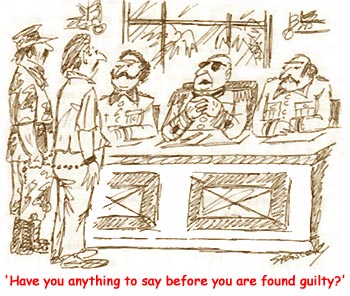 Cartoon: Len Spencer
|
As a result of international pressure from organisations such as the Amnesty international, the paramilitary police force has started arresting critics and charging them with fabricated offences such as petty thefts and traffic violations. The authorities are hoping to ward off international attention by such methods.
At the stage of police interrogation, the National Security Service, under the direct supervision of the President, treats such 'prisoners of conscience' in cruel, inhuman, and degrading manner. The methods of torture employed by the National Security Service include beating, gang rape, and putting people on handcuffs and leg stocks for months, to get inadmissible confessions.
Up until now it did not matter to much of the international community whether or not the President of the Maldives and his paramilitary police force treated 'political prisoners' or 'prisoners of conscience' in such cruel, inhuman and degrading manner. However, since the September Eleventh Terrorist Attack on the United States, it has now become a duty of the international community to suppress and control 'terrorism', which must include 'political terrorism'.
This article briefly examines the theory of 'political terrorism' and specific instances of 'political terrorism' in the Maldives and highlights the consequences that are likely to follow.
Political Terrorism
It is generally accepted that 'terrorism' is an illusive concept with a multitude of dimensions, and so is 'political terrorism'. The term 'political terrorism' is often described by experts as the use of violence by an established authority for political ends, and includes any use of violence for the purposes of putting the public or any section of the public in fear.
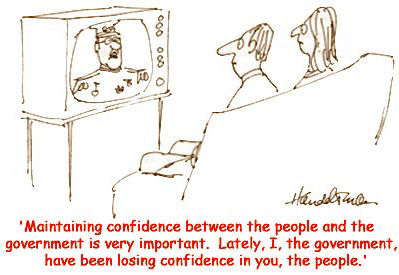 Cartoon: J.B. Handelsman Cartoon: J.B. Handelsman |
Grant Wardlaw, an expert on terrorism, in his book Political Terrorism: Theory, Tactics, and Counter-measures defined 'political terrorism' as:
'The use, or threat of use, of violence by an individual or a group, whether acting for or in opposition to established authority, when such action is designed to create extreme anxiety and/or fear inducing effects in a target group larger than the immediate victims for the purpose of coercing that group into acceding to the political demands of the perpetrators.'
Of course, this is one view. One person's perspective of 'political terrorism' can be another person's perspective of maintaining public order to achieve peace and harmony. In the Maldives, the National Security Service tries to justify violence against members of the public (which includes beating, gang rape, and putting people on handcuffs and on leg stocks for months) as means of maintaining public order for the sake of peace and harmony.
The means of violence used by the National Security Service against 'political prisoners' or 'prisoners of conscience' appear to be within the definition of 'political terrorism' according to the Wardlaw Theory. When all or some aspects of that theory is legislated domestically, then the theory becomes part of the domestic law. The term 'terrorism' is defined in the Prevention of Terrorism Act 1990, Maldives Law No. 90/10, (Terrorism Act) practically encompassing all the elements of the Wardlaw Theory and hence the theory of 'political terrorism' becomes part of the domestic law of the Maldives. There is no doubt that the Terrorism Act being a Public Act of Parliament applies to the public in general including the President and the members of the National Security Service.
The concept of Wardlaw Theory as legislated by section 2 of the Terrorism Act includes several criminal offences. Those offences can be categorised as the use of violence for political purposes, hostage taking and kidnapping, hijacking, manufacturing or trafficking of weapons or explosives, the use of weapons or explosives, arson, and the use of threat against persons or property. Without limiting the generality of these categories, the definition further provides that 'terrorism' includes:
Murder or other forms of violence used to physically harm any person or persons in the pursuit of a political aim or to put them in fear.
An act that creates fear amongst the members of the public, including any means of threat used against a person, life or property.
[These provisions are translated from their original text in Dhivehi]
Thus, any of the prescribed criminal offences when committed against the public or any section of the public by either a member of the public or a member of the National Security Service in pursuit of a political aim will constitute 'political terrorism'. This includes any act of violence accompanied by the following elements:
The act of violence must be committed by a person in authority;
The act of violence must be used to physically harm any person or persons;
The act of violence must create anxiety or fear in a target group larger than the immediate victims;
The act of violence must be committed for the purpose of coercing that group into acceding to the political demands of the perpetrators.
Police Brutality and 'Political Terrorism'
Under the current laws of the Maldives, 'political prisoners' can be held in police custody for up to 45 days (which can be extended by permission of the President) in circumstances facilitating torture or ill-treatment.
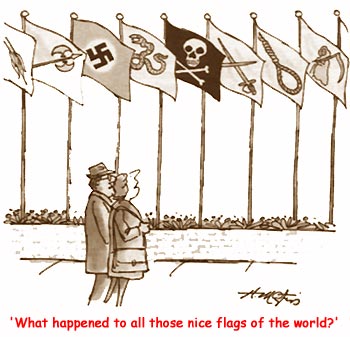 Cartoon: Henry Martin
|
There are many instances of torture or ill-treatment, which constitute 'political terrorism' according to the above definition. For example, a prisoner detained for questioning by the National Security Service, complained of prison conditions amounting to ill-treatment. He said that he had been held for over nine months in solitary confinement, and that for over 45 days he had been kept in handcuffs joined by a single hinge, allowing only extremely restricted movement (refer to the Amnesty International Report 1993).
'A part of our lives ends, never to be revived again'
'The first blow makes the prisoner realise that he is helpless - and thus it contains the essence of all that will follow: they can hit me in the face with their fists, the victim feels with a kind of torpid astonishment; and he concludes with an equally torpid certainty: they will do to me what they like. Nobody knows about me outside, nobody will stand up for me... It does not mean much when someone who has never been beaten up makes the rhetorical statement that the first blow robs the prisoner of his human dignity. I am sure that it robs him of more: of something one might call his belief in the world. The expectation, the certainty to get help is one of man's fundamental experiences... Just a moment, says the mother to her child when it is in pain, there'll be a hot-water bottle, a cup of tea, you won't be allowed to suffer... Even on the battle-field the Red Cross helper finds his way to the injured. But with the first blow of the policeman's fist, from which there is no protection and which is not warded off by a helping hand, a part of our lives ends, never to be revived again.'
Jean Amery, a member of the Belgian resistance in WW2 who was tortured by the German SS.
Quoted from 'A Flame in Barbed Wire - The Story of Amnesty International' by Egon Larsen.
|
Other examples include methods of torture employed by the National Security Service such as leaving people for long periods on chairs with their hands handcuffed to their feet, and forcing them to stand on chairs for hours with arms outstretched (refer to the Amnesty International Report 1998).
According to a female prisoner held by the National Security Service in Gaamaadhoo Prison, male and female prisoners had been handcuffed to coconut palms, in front of prison cells, when they try to sleep. During her five-day detention there, she saw girls aged between 13 and 18 almost permanently handcuffed in their cells. Male soldiers jabbed the ribs of female prisoners with wooden batons to wake them for dawn prayers, pointing the batons in a humiliating way, especially at the girls' genitals. It was learnt that a girl had died in Gaamaadhoo Prison in 1994 after she was gang-raped by guards of the National Security Service (refer to the Amnesty International Report 1999).
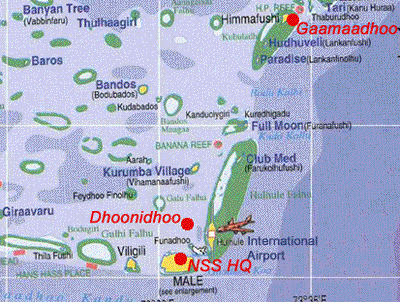 Malé and nearby islands
(click on map for larger version)
|
Reports also confirmed that prison guards from the National Security Service regularly beat prisoners, at times on orders from the senior warden (Amnesty International Report 2000). Recently, information came to light that at least three parliamentary candidates detained in the run up to the November 1999 parliamentary elections were tortured or ill-treated in custody. They were held in Dhoonidhoo detention centre in early November 1999 where they were deprived of sleep for several days, forced to sit on stools in the rain, and beaten every time they fell asleep (Amnesty International Report 2001).
These are examples of violent means used by persons in authority - members of the National Security Service. These violent means are used to physically harm people who are detained for allegedly committing 'political offences' - i.e. criticising the policies of the current President and his government. These acts of violence create anxiety and fear among the people who do not support the President and his government.
The National Security Service use such violent means against 'political prisoners' or 'prisoners of conscience' in pursuit of a political aim - that political aim being the purpose of coercing the public into acceding to the political whims and demands of the President and his government. Consequently, there is a fear created among the public in general.
Therefore, such violent means used by the National Security Service against 'political prisoners' or 'prisoners of conscience' constitute 'political terrorism' as defined in section 2 of the Terrorism Act.
It should be noted that neither the President nor his National Security Service personnel have a warrant to treat members of the public in a cruel, inhuman, and degrading manner.
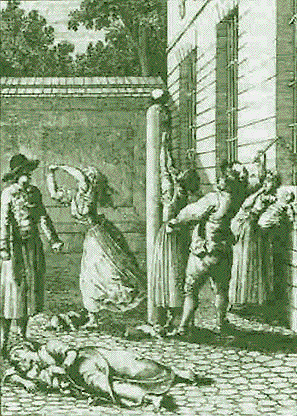 Use of the pillory to whip unmarried mothers in Europe, 1782.
Women are whipped (without a pillory) for the same 'offence' in modern Maldives.
|
The Preamble of the Universal Declaration of Human Rights states:
Whereas recognition of the inherent dignity and of the equal and inalienable rights of all members of the human family is the foundation of freedom, justice and peace in the world,
Whereas disregard and contempt for human rights have resulted in barbarous acts which have outraged the conscience of mankind, and the advent of a world in which human beings shall enjoy freedom of speech and belief and freedom from fear and want has been proclaimed as the highest aspiration of the common people,
Whereas it is essential, if man is not to be compelled to have recourse, as a last resort, to rebellion against tyranny and oppression, that human rights should be protected by the rule of law.
If the government of the Maldives does not adhere to the fundamental rules of civilised human society, the country is likely to pay a huge price in the long run.
It may be too late before the people realise that they have lost the smartest brains of their country. It may be too late before they realise that no tourists are visiting their country. It may be too late before they realise that their economy is beyond repair. It may too late before they realise that their country has been going down like the Titanic - sunk not by rising sea levels but by 'political terrorism'. If the international community raises these concerns with the President, he is likely to say that "these are rumours spread by expatriates or Maldivian dissidents living abroad to discredit his government and his 'developmental success' over the past 23 years".
Alternatively, he may say that 'these are matters of concern to his government and his government has been working on improving the criminal justice system including the treatment of offenders, but haven't quite been able to achieve the expected international standards'. This is his typical dialogue when he is faced with situations where he cannot justify his actions to international organisations.
How could the President and his government say that these are rumours when they are events recorded by Amnesty International and the United States Department of State?
How could the President say that his government has been working on improving the criminal justice system, when his government has not taken any measures to control and regulate police brutality over the past 23 years?
His government has not explicitly ratified the universal law of all human beings - the Universal Declaration of Human Rights and its Protocols. His government has not passed any legislation to control powers of the police, to guarantee individual privacy, or provide rules of criminal evidence on trials.
Most importantly, the recent Constitution re-written by his government does not guarantee individual rights. Rather it reinforces and even enhances the President's power and authority. There is no bill of rights or rule of law in the Maldives. So how could the President say that his government has been trying to improve the criminal justice system over the past 23 years?
The truth is that the President or his government does not want any changes to the criminal justice system in the Maldives. If the government of the Maldives does not adhere to the rules of the civilised international human community, then the country is likely to pay a huge price in the long run. It may be too late before the people wake up and realise that 'political terrorism' has brought down their country.
Torture techniques in Maldives
from Majid's Pages
Solitary confinement by itself or together with one or more of the following methods of torture. Most solitary confinement cells are made of corrugated iron with barely enough room to move the body. There is no room to lie down. In the sun, the temperatures in these cells could exceed 40 degrees Celsius.
Handcuffing for extended periods, which may last months. Handcuffs are used to cuff together all four limbs in all imaginable permutations and combinations.
Putting in stocks: The victim is restrained with his or her ankles and wrists locked in tiny holes in a block of wood. The victim remains bent and does not have the use of his/her hands when eating. Defecation and urination is done on the spot and the victim remains with his or her own human waste for days on end. Victims of the stocks almost invariably suffer from spinal conditions for life, if they survive this ordeal.
Hanging by the arms, legs, fingers and toes.
Using a bulldozer to haul the cuffed victim on top of a sand dune about 2-3 metres high and letting him roll down on a base of sharp stone chips. This procedure is carried out repeatedly for hours on end.
Electric shock. In most cases, the victim is made to stand on a sheet of corrugated iron and low voltage electricity is applied. (This is a common method used for premeditated murder)
Gang rape of women prisoners. Sometimes other women inmates are forced to watch this in order to inflict psychological torture on them. (Those who have been forced to watch this are known to have hung themselves)
Urinating and defecating on victims. Very senior personnel in attendance usually carry this out while the victim is undergoing another method of torture.
"Mounting on the angle": The victimís arms are passed backwards through the vertical bars (about 60 cm apart) of the vent above the door in a prison cell. The wrists are then tightly handcuffed. The body is left dangling for hours at a time. The victim almost invariably has both shoulders and/or elbows dislocated during this exercise.
Indiscriminate beating. Often officials wearing military-style boots stomp on the victim. (In one well-documented case, a 17 year old youth was beaten up on the spinal area, in the interrogation room. He was paralysed for life.)
Lashed to trees in front of cell blocks. Female victims are left in various degrees of nakedness.
Forcing detainees to stand on a chair for hours with arms outstretched and a heavy object in each palm.
Made to squat on the toes, with a length of timber between the upper and lower legs, tightly tucked behind the knee. The weight of the body results in the dislocation of the knee by a slow process.
|